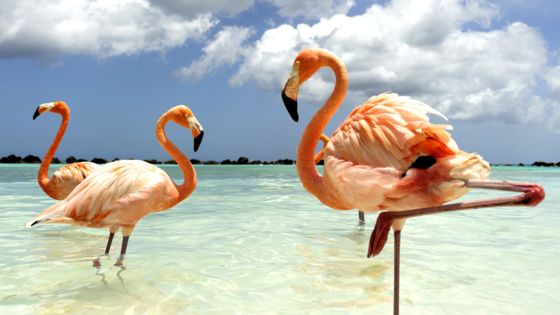
Flamingos expend less energy standing on one leg than in a two-legged stance, scientists have confirmed.
It may be their signature pose, but how and why the birds perch on one limb has been a longstanding puzzle.
Now, a team from the US has shown that flamingos employ no active muscular effort when they`re unipedal, meaning they are also expending less energy.
A passive mechanism is engaged in the one-legged position, allowing flamingos to stand proud while having a doze.
Previously, researchers had wondered whether the one-legged position might help reduce muscle fatigue, as the birds alternated from standing on one leg to the other.
Other teams have proposed that this behaviour helps regulate body temperature.
Now, Prof Young-Hui Chang, from the Georgia Institute of Technology (Georgia Tech) in Atlanta, and Lena H Ting, of Atlanta`s Emory University, have uncovered the mechanical secrets behind this impressive trick.
The researchers conducted several experiments with both live and dead birds. Amazingly, they found that flamingo cadavers could be made to stand one-legged without any external support.
They describe this phenomenon, as a "passive gravitational stay mechanism".
"If you look at the bird from the front, while they`re standing on one leg, the foot is directly beneath the body which means that their leg is angled inward. That`s the pose you have to strike in order to engage the stay mechanism," Prof Chang told BBC News.
However, dead birds cannot stand unsupported on two legs, suggesting a greater role for active muscle force in this posture: "If you tilt it to the vertical, like you would if you were standing on two legs, the whole thing disengages," said the director of the Comparative Neuromechanics Laboratory at Georgia Tech.
The researchers also studied live birds, and showed that when they were standing one-legged and resting, they hardly moved at all - underlining the stability of this passive position. However, the birds did sway somewhat when the one-legged posture was combined with an activity, such as grooming or calling out.
Prof Chang said the underlying anatomical apparatus that enables the passive posture was not yet understood - this is the next step in the team`s research. But he explained that the phenomenon did not involve the limb joints locking.
"A lock would imply that it`s fixed in both directions. What we found is that it`s fixed in one direction, but flexible in the other direction, so we call it a `stay` rather than a `lock`. It`s more akin to a doorstop," he told me.
Dr Matthew Anderson, an experimental psychologist who specialises in animal behaviour at St Joseph`s University in Philadelphia, described the team`s results as a "significant step forward".
The researcher, who was not involved with the latest study, added: "They begin to answer the question of how flamingos are able to rest on one leg. Importantly, these authors do not examine when and where flamingos actually utilise the behaviour in question, and thus this paper does not really address the issue of why flamingos rest while on one leg."
Dr Anderson`s own research suggests that the birds adopt the unusual posture in order to conserve heat. Among other things, his team found that the number of birds resting on one leg falls as temperatures rise.
"Providing evidence of the mechanism that supports/allows for the behaviour to occur does not necessarily provide insight into why it happens in the first place."
Follow Paul on Twitter.


0 comments:
Post a Comment